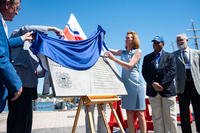U.S. troop withdrawal could be up for negotiation if North Korea and South Korea can solidify a lasting peace deal, Defense Secretary Jim Mattis said Friday.
Mattis was cautious in his response to a question on the potential for withdrawals following the historic meeting Friday of the leaders of North and South Korea.
"That's part of the issues that we'll be discussing in negotiations with our allies first, and of course with North Korea," he said.
He made no predictions on the status of the 28,000 U.S. troops now stationed in South Korea.
"I think for right now we just have to go along with the process, have the negotiations and not try to make pre-conditions or presumptions about how it's going to go," he said.
"The diplomats are going to have to go to work now," Mattis said at the Pentagon after an honor cordon for visiting Polish Defense Minister Mariusz Blaszczak.
The prospect that a U.S. Secretary of Defense would have entertained even the vaguest thought of troop withdrawal from the peninsula would have been unthinkable only a few weeks ago, but North Korean leader Kim Jong-un's attempted transformation from dictator and nuclear bully to potential peace partner has altered the diplomatic and military equation.
"We will build, through confidence building measures, a degree of trust to go forward. So we'll see how things go," Mattis said. "I don't have a crystal ball. I can tell you we are optimistic right now that there's opportunity here that we have never enjoyed since 1950," when the Korean War started.
Last week, the U.S. held a drill for the evacuation of civilian personnel from South Korea in the event of war. On Friday, a smiling Kim stepped across a line in the Demilitarized Zone and was greeted by a beaming South Korean President Moon Jae-in.
They shook hands, took a walk together, planted a tree together and later signed the "Panmunjom Declaration for Peace, Prosperity and Unification on the Korean Peninsula."
The declaration held out the possibility for the denuclearization of the peninsula and a formal end to the Korean War, which concluded with an armistice in 1953.
The Kim-Moon meeting also set the stage for a summit between Kim and President Donald Trump at the end of May or early June. A site for the talks has yet to be determined.
"We seek a future of peace, prosperity, and harmony for the whole Korean Peninsula unlocking, not only a brighter future for the people of Korea, but for the people of the world," Trump said at the White House. "However, in pursuit of that goal, we will not repeat the mistake of past administrations. Maximum pressure will continue until denuclearization occurs."
-- Richard Sisk can be reached at Richard.Sisk@Military.com.






























